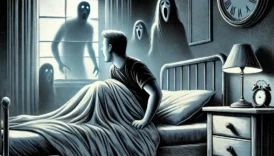Nightmares: Their Meaning, Causes, and How to Cope
Nightmares are one of the most unsettling and vivid experiences during sleep, leaving a lasting impact on the mind. While almost everyone has encountered a nightmare at some point in life, their true causes, underlying mechanisms, and how to deal with them remain intriguing topics. This comprehensive guide delves into the psychological and biological roots of nightmares, the triggers that make them more frequent, and actionable strategies to confront them effectively.
- Nightmares: Their Meaning, Causes, and How to Cope
- 1. What Are Nightmares?
- 2. Origins and Psychological Foundations of Nightmares
- 2.1 Sigmund Freud’s Psychoanalytic Perspective
- 2.2 Carl Jung’s Archetype Theory
- 2.3 Neuroscience and Modern Research
- 3. Common Triggers for Nightmares
- 3.1 Psychological Stress and Anxiety
- 3.2 Trauma and PTSD
- 3.3 Medications and Substances
- 3.4 Sleep Patterns
- 4. Psychological Impact of Nightmares
- 5. How to Cope with Nightmares
- 5.1 Cognitive Behavioral Therapy (CBT)
- 5.2 Imagery Rehearsal Therapy (IRT)
- 5.3 Improving Sleep Hygiene
- 5.4 Relaxation Techniques
- 6. Preventive Measures
- References
1. What Are Nightmares?
Nightmares are intense, distressing dreams that often evoke feelings of fear, anxiety, or dread, waking the sleeper and disrupting the quality of their rest. Typically occurring during the REM (Rapid Eye Movement) phase of sleep, nightmares are often vivid and emotionally charged.
- Fear as a Core Emotion: The hallmark of nightmares is the intense fear they provoke.
- Vivid and Immersive: The dream feels incredibly real, amplifying the distress.
- Aftermath: Many people experience lingering unease, sweating, or a racing heart after waking from a nightmare.
Key Insight: Unlike a bad dream, a nightmare is marked by its emotional intensity and the impact it has on waking life.
2. Origins and Psychological Foundations of Nightmares
Nightmares are complex phenomena influenced by psychological, neurological, and external factors. Let’s examine them through different perspectives:
2.1 Sigmund Freud’s Psychoanalytic Perspective
According to Freud, dreams (including nightmares) are a window into the unconscious mind. He argued that nightmares often reveal repressed fears or desires struggling to surface. (Source: Freud, S. (1900). The Interpretation of Dreams.)
2.2 Carl Jung’s Archetype Theory
Jung saw nightmares as an expression of the “shadow,” an archetype representing the darker, hidden aspects of the psyche. These dreams serve as a confrontation with personal and collective unconscious fears. (Source: Jung, C. G. (1964). Man and His Symbols.)
2.3 Neuroscience and Modern Research
Current studies link nightmares to hyperactivity in the amygdala (responsible for processing emotions) and irregularities in REM sleep cycles. Stress, trauma, and neurological imbalances often exacerbate these disruptions. (Source: American Academy of Sleep Medicine, International Classification of Sleep Disorders, 3rd Edition.)
3. Common Triggers for Nightmares
Several factors can make nightmares more frequent and intense:
3.1 Psychological Stress and Anxiety
- Workplace Stress: Deadlines, overwork, or burnout are major contributors to stress-induced nightmares.
- Personal Issues: Relationship conflicts, financial troubles, or significant life changes often manifest in dream content.
3.2 Trauma and PTSD
- Traumatic Events: Survivors of accidents, abuse, or natural disasters often report recurring nightmares.
- Military and Combat: Veterans are particularly vulnerable to nightmares stemming from post-traumatic stress disorder (PTSD).
(Source: American Psychiatric Association (2013). Diagnostic and Statistical Manual of Mental Disorders, 5th Edition.)
3.3 Medications and Substances
- Prescription Medications: Antidepressants and sleep aids can alter REM sleep, sometimes leading to vivid nightmares.
- Alcohol and Drug Use: Substance abuse, as well as withdrawal, disrupts the brain’s chemical balance, intensifying nightmares.
3.4 Sleep Patterns
- Irregular Sleep Schedules: Constantly shifting bedtime disrupts REM cycles, increasing nightmare occurrences.
- Sleep Disorders: Conditions like sleep apnea can fragment sleep and elevate nightmare frequency.
4. Psychological Impact of Nightmares
Nightmares do more than disturb sleep; they can leave lasting effects on daily life:
- Sleep Disruption: Frequent nightmares impair sleep quality, leading to daytime fatigue.
- Heightened Anxiety: The fear of recurring nightmares may cause chronic stress or even insomnia.
- Avoidance Behavior: Some individuals may develop a fear of sleeping altogether, further complicating their health.
5. How to Cope with Nightmares
Addressing nightmares effectively involves a combination of therapeutic techniques, lifestyle changes, and mental health support.
5.1 Cognitive Behavioral Therapy (CBT)
CBT helps individuals identify and reframe negative thought patterns contributing to their nightmares. Techniques like relaxation training and exposure therapy are highly effective. (Source: Perlis, M. L., & Smith, M. T. (2008). Cognitive Behavioral Therapy for Insomnia.)
5.2 Imagery Rehearsal Therapy (IRT)
This method involves consciously rewriting the narrative of a nightmare into a positive or less distressing scenario, effectively “retraining” the brain.
5.3 Improving Sleep Hygiene
- Regular Sleep Routine: Going to bed and waking up at consistent times helps regulate REM cycles.
- Create a Calming Environment: A quiet, dark, and cool room enhances sleep quality.
- Limit Screen Time: Avoid electronics at least an hour before bed to reduce stimulation.
5.4 Relaxation Techniques
- Meditation: Mindfulness practices help calm the mind before bed.
- Progressive Muscle Relaxation: Alternately tensing and relaxing muscle groups eases physical tension.
6. Preventive Measures
To minimize nightmares, focus on proactive strategies:
- Manage Daily Stress: Regular exercise, hobbies, and leisure activities are excellent stress relievers.
- Healthy Diet: Avoid excessive caffeine, alcohol, and heavy meals before bedtime.
- Professional Support: Consult a psychologist or sleep specialist if nightmares persist.
Nightmares are a normal yet impactful aspect of the human experience. Understanding their origins, triggers, and psychological underpinnings can empower individuals to confront and overcome them. Through evidence-based therapies and healthy habits, it’s possible to reduce the frequency and severity of nightmares, paving the way for restful and restorative sleep.
By addressing this issue with care and the tools discussed, you can reclaim your nights and improve your overall well-being.
References
- Freud, S. (1900). The Interpretation of Dreams.
- Jung, C. G. (1964). Man and His Symbols.
- American Psychiatric Association. (2013). Diagnostic and Statistical Manual of Mental Disorders, 5th Edition.
- American Academy of Sleep Medicine. International Classification of Sleep Disorders, 3rd Edition.
- Perlis, M. L., & Smith, M. T. (2008). Cognitive Behavioral Therapy for Insomnia.
This guide aims to shed light on the science and psychology of nightmares while offering practical solutions to improve your sleep and overall mental health.





